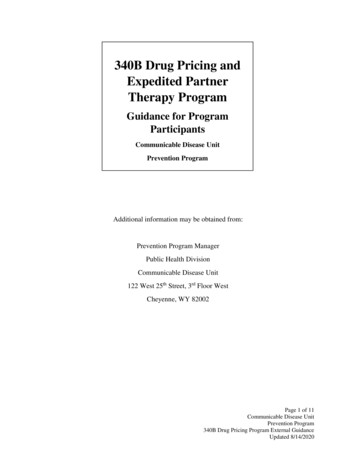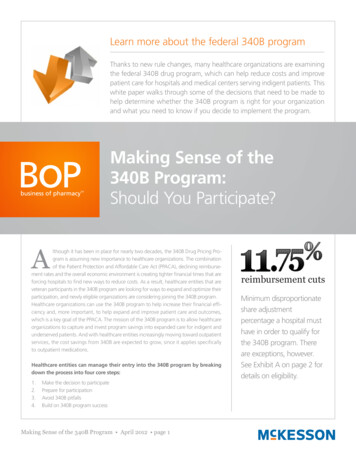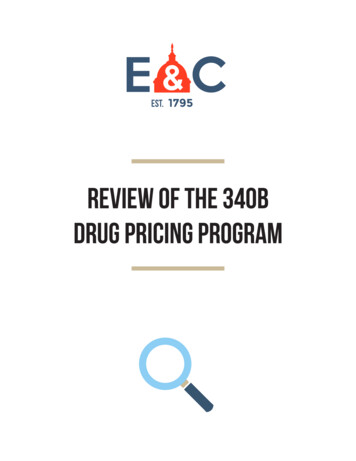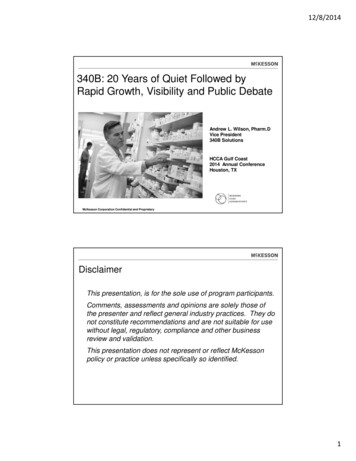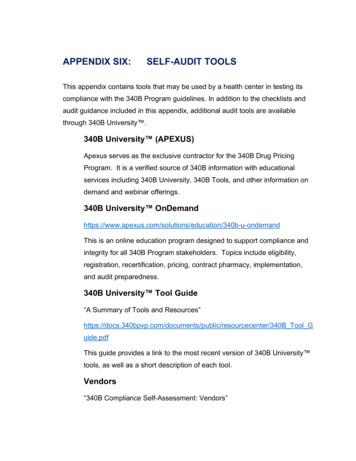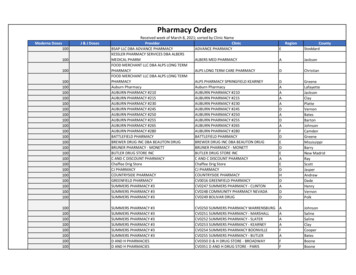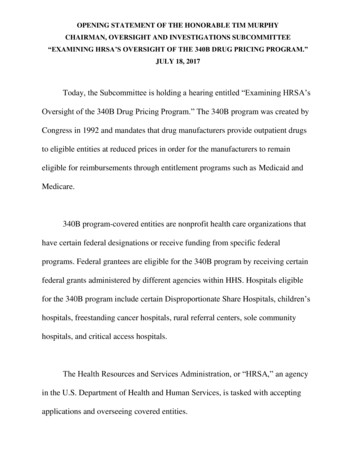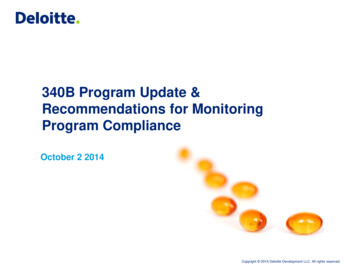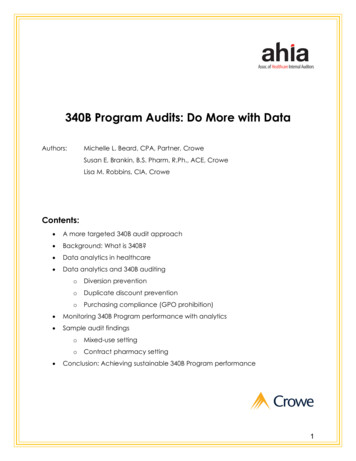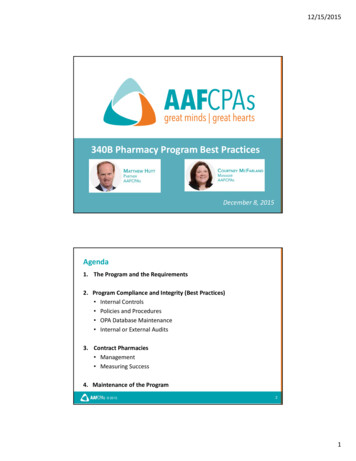
Transcription
12/15/2015340B Pharmacy Program Best PracticesDecember 8, 2015Agenda1. The Program and the Requirements2. Program Compliance and Integrity (Best Practices) Internal Controls Policies and Procedures OPA Database Maintenance Internal or External Audits3. Contract Pharmacies Management Measuring Success4. Maintenance of the Program 201521
12/15/2015The Program and Requirements In 1992, section 340B of the Public Health Service Act introduced the340B Drug Pricing Program with the intent of permitting covered entities“to stretch scarce Federal resources as far as possible, reaching moreeligible patients and providing more comprehensive services”. Covered entities are eligible to purchase certain outpatient drugs at orbelow statutorily defined discount prices (340B drugs) thereby allowingthem to achieve substantial savings on drug expenses. The Affordable Care Act expanded access of the Program to certainsafety net providers including Federally Qualified Health Centers.FQHCs are able to provide these discounted drugs at their internalpharmacies or they are able to contract with a pharmacy to dispensedrugs on their behalf. 20153The Program and Requirements The Office of Pharmacy Affairs (OPA) administers and regulates theProgram in order to ensure the intent and integrity of the Program.The FQHC is responsible to create and maintain policies, proceduresand records, of both in‐house and contract pharmacies, to provecompliance with all requirements of the Program. In August, 2015, the Department of Health and Human Servicesissued a Renewable Identification Number (0906‐AB08) providingfurther guidance on the Program and clarifying certain compliancerequirements. 201542
12/15/2015The Program and RequirementsCovered entities are subject to audit by the producer of the drug (the Manufacturer) or theFederal Government at any time during their participation in the Program.Compliance findings generally fall into two categories:1.Non‐systemic: Where the covered entity appears to maintain auditable recordsproving compliance, however, they are unable to provide documentation regardingspecific transaction(s). This type of finding typically results in repayment to theManufacturer for all ineligible scripts, but does not result in the revocation ofparticipation in the Program.2.Systemic: Where the covered entity is found to have in‐auditable, inaccurate orinsufficient records and/or procedures. This type of finding typically results inrevocation of participation in the Program and repayment to manufacturers.All findings are made publically known and available. Re‐instatement into the Program ispossible after revocation; however a detailed corrective action plan is required. 20155The Program and RequirementsThough there are multiple compliance requirements of the Program,there are two main prohibitions :1.Diversion:The resale of 340B drugs to a person who is not a patient of thecovered entity.Diversion may also occur by dispensing 340B drugs for a serviceor scope of service which is not covered by the Program, or theFederal grant which triggers eligibility to participate in theProgram. 201563
12/15/2015The Program and Requirements2.Duplicate Discount:When a Manufacturer is required to pay discounts or rebates under boththe Program and the Medicaid Drug Rebate Program. Duplicate discountsoccur when the covered entity bills Medicaid contrary to informationincluded in the Medicaid exclusion file.OPA 340B Database Reporting 20157The Program and Requirements2.Duplicate Discount (Continued):Initially, the Rebate Program was limited to Medicaid Fee For Service (FFS)drugs only, however, section 2501(c) amended the Social Security Act tospecify that covered outpatient drugs dispensed by Medicaid ManagedCare Organizations (MCOs) are not subject to a rebate if also subject to adiscount under section 340B of the Act.The determination of certain MCOs and their Medicaid inclusion is oftendifficult and should be carefully monitored. 201584
12/15/2015The Program and Requirements2.Duplicate Discount (Continued):Contract pharmacies are not issued a 340B provider number and aretherefore excluded from providing 340B drugs to eligible patients.For this reason, all contract pharmacies must be carve‐out (Medicaidpatients are never dispensed 340B drugs) unless there is a specificagreement and contract with the State, the covered entity and thecontract pharmacy allowing such distribution.It is the covered entity’s responsibility to notify OPA, HRSA of thisarrangement 20159The Program and Requirements2.Duplicate Discount (Continued):Massachusetts State Policy (130 CMR 406.000(D)(2)(a) allows a coveredentity to contract with a MassHealth pharmacy provider to dispense 340Bdrugs, however: The subcontracts must be in writing Ensure continuity of care Specify that the 340B‐covered entity pays the pharmacy Specify that the payment constitutes payment in full for 340B drugsprovided to MassHealth members Be consistent with all applicable provisions Subject to MassHealth approval 2015105
12/15/2015Program Compliance and Integrity: Best PracticesHow are you monitoring compliance with themultiple requirements of the program?1.OPADatabase 201511Program Compliance and Integrity: Best PracticesOPA Database Maintenance1. Keep all contact information up to date and accurate Best practice to have two separate people as authorizing official and primarycontact2. Keep all changes in scope of services or service locations up to date and accurate3. Keep status of Medicaid billing and all NPI numbers up to date and accurate4. Recertify annually, and update the database as changes occurAdditional for contract pharmacy arrangements5. Review listed authorized pharmacies monthly for reasonableness Non‐mail order pharmacies that are out of the State of the covered entity pose agreater risk of non‐compliance with the program due to patient definition. 2015126
12/15/2015Program Compliance and Integrity: Best Practices1.OPADatabase2.Policies andProcedures 201513Program Compliance and Integrity: Best PracticesPolicies and ProceduresPolicies and Procedures surrounding the compliance and management of theprogram should be written and must address the following:1.2.3.4.A summary of all operating sites (including contract)Name of the person responsible for maintaining compliance with theProgramThe scope of services/grants under which scripts are eligibleSoftware: What software is used to manage inventory?How are price changes monitored and updated?Who is the key contact for software issues and updates?Consider obtaining a Service Organization Control Report attesting to the adequacy ofcontrols surrounding your data. 2015147
12/15/2015Program Compliance and Integrity: Best PracticesPolicies and Procedures (Continued)5.Preventing Diversion: Patient Definition When is a patient considered eligible?If a patient has not been seen by a covered entity prescriber in over 1 year, does theprescription qualify?What about a referral prescription? Does the covered entity have complete care of thepatient or the specific prescription?How often, and how are changes in covered entity eligible prescribers communicated to thepharmacy locations?Insurance status: Carve‐ In accepting Medicaid, or Carve‐OutAny moonlighting prescribers? Risk for diversion. 201515Program Compliance and Integrity: Best PracticesPolicies and Procedures (Continued)6.Preventing Duplicate Discounts: Medicaid Billing Do you accept Medicaid?Are MCOs specifically excluded? If not, which MCOs are still processed?Include specific spot checks of data to ensure no Medicaid claims are being erroneouslyprocessed.7. Who is responsible for updating the OPA database? How often is it monitored andwho approves changes?8.Physician Administered Drugs: How are these monitored and tracked? These drugsare under the same compliance regulations. 2015168
12/15/2015Program Compliance and Integrity: Best PracticesPolicies and Procedures (Continued)9.Who is responsible for training pharmacy staff? What training materials areprovided and who updates pharmacy staff on changing 340B rules, trends,compliance and changes in patient definition or scope of services?10. Financial: How are pharmacy transactions recorded in the general ledger?Who reviews monthly activity and approves recording the activity?How are price changes recorded in the general ledger? 201517Program Compliance and Integrity: Best PracticesPolicies and Procedures (Continued)11. Inventory reconciliation andcounts: If offering retail and 340B drugs,details on how the inventory isseparatedDocumentation of annual physicalinventoryBest Practice: Quarterlyreconciliation of 340B inventory (seeright) 2015189
12/15/2015Program Compliance and Integrity: Best PracticesPolicies and Procedures (Continued)12. The timing, extent and frequency of self‐audits, or external audits Best Practice: At least annually. All results should be documented Need documentation of what is considered a material non‐compliance; and theprocess for self‐reporting13. Policies and procedures should have documented approval by the Board orDirectors and/or C‐Suite (CEO, COO, CFO and etc) 201519Program Compliance and Integrity: Best PracticesPolicies and Procedures (Continued)Additional for Contract Pharmacy Arrangements:1. Review and conclude on internal controls at the contract pharmacy Obtain a Service Organization Control Report attesting to controls of the prescription data.The covered entity is responsible for compliance with the program, if there is an issue withthe internal mechanisms determining eligibility, it is the covered entity’s compliance issue.2. Procedures for and timing of monitoring the OPA database for new or unusuallocations3. Results of, and procedures for performing internal or external audits (Best Practice:at least annually) 20152010
12/15/2015Program Compliance and Integrity: Best PracticesPolicies and Procedures (Continued)Additional for Contract Pharmacy Arrangements:4. Documentation of how sales data is reviewed for reasonableness (Best Practice:monthly)5. Documentation of how changes in patients, prescribers and scope of services iscommunicated to the contract pharmacy6. How fees and remediation costs are monitored and tracked in order to preserve theintent of the Program (see later slides)21 2015Contract Pharmacies: Management and Measuring Success3.ContractPharmacies 20152211
12/15/2015Contract Pharmacies: Management and Measuring SuccessA couple of small reminders!1. The covered entity is responsible for compliance with the Program2. The Program is designed to “to stretch scarce Federal resources as far aspossible, reaching more eligible patients and providing morecomprehensive services”. 201523Contract Pharmacies: Management and Measuring Success1. Meet with a representative of your contractpharmacy and understand: How is eligibility determined? How is data flowing between you and thecontract pharmacy? How soon is data updated on the contractpharmacy side after changes or updates aremade by you? Understand the process of processing claims How is it determined that the lowest price drugis purchased? Understand fees and remediationrequirements Be sure you have the most up to datecontracts for all participating locations Understand if Medicaid claims are processed 20152412
12/15/2015Contract Pharmacies: Management and Measuring Success2. Program Integrity ‐ Perform monthly or quarterly reviewsof the following: Total gross profitTotal processing feesTotal remediation costsTotal value of all reversed claims (for errors)Consider: Is there an automatic stop on processing claims where thefee is higher than the potential revenue? If not, why? Are the fees paid typical for the industry? Are the feeshigh enough to threaten the integrity of the Program? Renegotiate contracts where necessary. The coveredentity isn’t the only one profiting!25 2015Maintenance of the Program4.Maintenance ofProgram3.ContractPharmacies 20152613
12/15/2015Maintenance of the ProgramWith proper policies and procedures in place,maintenance of the Program is simplified, butminimum requirements are as follows:1. Perform frequent self audits, or have an external auditdone. Document findings and corrective actions2.Seek out training to stay up to date with changingrequirements and trends. Join the email list for HRSA 340B updates 201527Maintenance of the Program3.Document how savings from the 340B program are re‐invested back into the covered entity.Informally: Show total net profit of the program and compare to non‐funded or under‐funded programs run by the coveredentity (such as a residency program, or under‐fundedsocial program) Show profits set aside for future capital expansion andimprovements 20152814
12/15/2015Maintenance of the Program3.Document how savings from the 340B program are re‐invested back into the covered entity.Formally: Complete a formal worksheet documenting total savingsand the distribution of the savings throughout the coveredentity. Template available if interested! 201529Slides & CPE!For access to the slides & CPE, please complete theattendance sheet including your email address and allinformation will be made available to you.To receive CPE credit: You must fill out the evaluationform and sign‐in & sign‐out on the sheet provided 201515
12/15/2015Thank You!For more information, visit: www.aafcpa.com 201516
Program Compliance and Integrity: Best Practices 11. Inventory reconciliation and counts: If offering retail and 340B drugs, details on how the inventory is separated Documentation of annual physical inventory Best Practice: Quarterly reconciliation of 340B inventory (see right)
